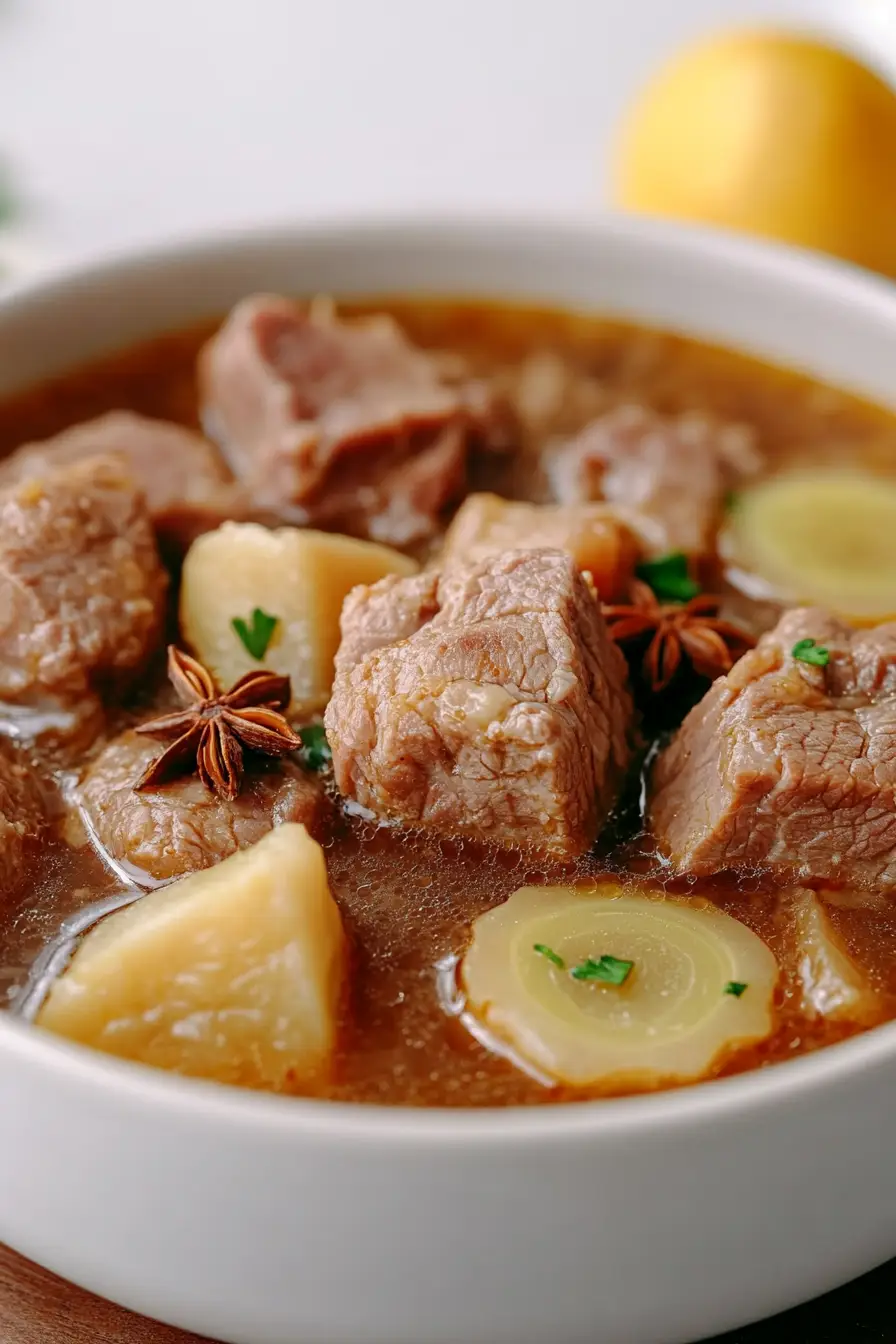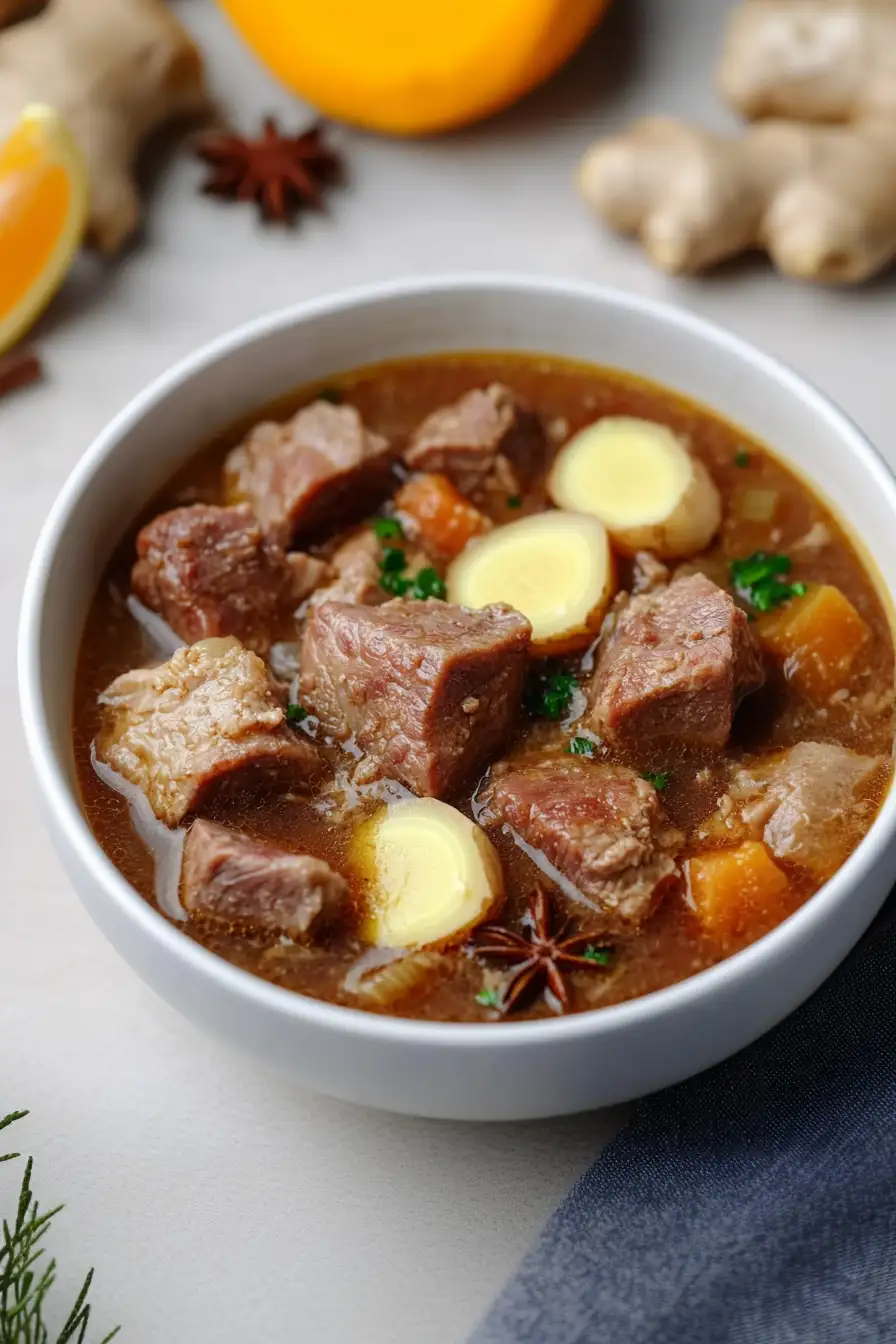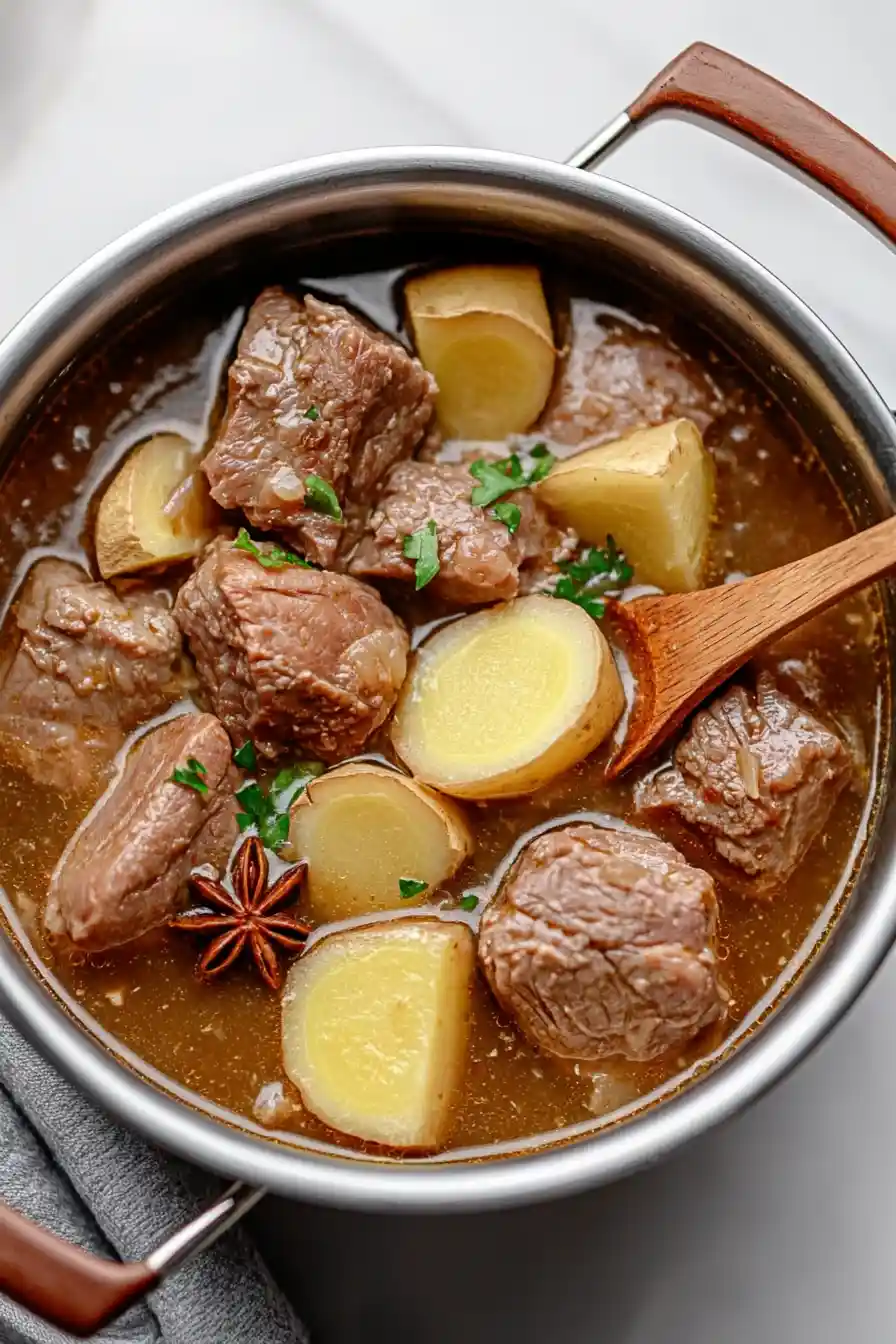Getting a warm, filling dinner on the table during busy weeknights can feel like an uphill battle. Between helping with homework, after-school activities, and those days when work runs late, finding time to cook a proper meal often seems impossible – and ordering takeout becomes all too tempting.
That’s where this Chinese pork stew comes to the rescue: it’s hearty and comforting, practically cooks itself in the pot, and uses simple ingredients you can grab during your weekly grocery run. Plus, it makes enough for leftovers that taste even better the next day.

Why You’ll Love This Chinese Pork Stew
- Rich Asian flavors – The combination of star anise, ginger, and Szechuan peppercorns creates that authentic Chinese taste you’d expect from your favorite restaurant.
- Simple ingredient list – With just a handful of ingredients, most of which are pantry staples, you can create this flavorful dish without hunting down hard-to-find items.
- Tender, juicy meat – The pork shoulder becomes incredibly tender during cooking, making each bite melt in your mouth.
- Meal prep friendly – This stew tastes even better the next day, making it perfect for making ahead and enjoying as leftovers.
- One-pot meal – Everything cooks in a single pot, which means less cleanup and more time to enjoy your meal.
Which Kind of Pork Should I Use?
Pork shoulder is the perfect cut for this Chinese stew, though you might see it labeled as pork butt or Boston butt at your local grocery store – don’t worry, they’re the same thing! This cut has great marbling (tiny streaks of fat throughout the meat) which helps keep the meat tender and juicy during the long cooking time. When shopping, look for meat that has a nice pink color with some white fat marbling, and avoid any cuts that look very pale or have dark spots. If you can’t find pork shoulder, you could substitute pork belly or even country-style ribs, though the cooking time might need to be adjusted slightly.

Options for Substitutions
This Chinese pork stew is pretty flexible with substitutions, though some ingredients are key for that authentic flavor:
- Pork shoulder: You can swap pork shoulder with pork belly or pork butt – they both have enough fat content to stay tender during long cooking. For a leaner option, try pork loin but reduce cooking time by about 30 minutes to prevent it from getting too dry.
- Tamari soy sauce: Regular soy sauce works perfectly fine here. If you need gluten-free options, coconut aminos make a good substitute but you might need to use a bit more since they’re less salty.
- Coconut oil: Any neutral cooking oil like vegetable, canola, or peanut oil will work just fine. Avoid olive oil as its flavor might compete with the Asian seasonings.
- Star anise: This gives a distinct flavor, but if you can’t find it, try using 1/4 teaspoon of Chinese five-spice powder instead, since star anise is one of its main components.
- Szechuan peppercorns: While these have a unique numbing quality, you can use regular black peppercorns in a pinch. The flavor will be different, but still good.
- Fresh ginger: In a bind, you can use 1/2 teaspoon of ground ginger, but fresh really makes a difference in this dish, so try to stick with it if possible.
Watch Out for These Mistakes While Cooking
The biggest mistake when making Chinese pork stew is rushing the cooking process – this cut of meat needs low and slow cooking (at least 2-3 hours) to become tender and develop those rich flavors you’re looking for. Another common error is skipping the crucial step of browning the meat properly; take your time to sear all sides until they’re golden brown, working in batches if necessary to avoid overcrowding the pot, which can lead to steaming instead of browning. The temperature control is also critical – once you’ve added all ingredients, resist the urge to boil the stew aggressively; instead, maintain a gentle simmer to prevent the meat from becoming tough and chewy. For the best flavor development, try toasting your star anise and Szechuan peppercorns in a dry pan for 30 seconds before adding them to the stew, and remember to cut your pork into consistently-sized chunks (about 1.5 inches) so they cook evenly.

What to Serve With Chinese Pork Stew?
This savory pork stew pairs perfectly with a big bowl of steamed white rice, which soaks up all those amazing flavors from the sauce. If you want to round out your meal, try serving it with some simple stir-fried bok choy or Chinese broccoli on the side – the green vegetables provide a nice contrast to the rich meat. You could also add some quick-pickled cucumbers for a cool, crunchy element that helps cut through the richness of the stew. For family-style serving, I like to put out some extra chili oil and chopped green onions so everyone can customize their bowls.
Storage Instructions
Keep: This Chinese pork stew gets even better after a day or two as the flavors continue to develop! Pop it in an airtight container and keep it in the fridge for up to 4 days. The sauce might solidify a bit when cold, but don’t worry – that’s totally normal.
Freeze: Good news – this stew freezes really well! Let it cool completely, then transfer to freezer-safe containers or heavy-duty freezer bags. It’ll keep nicely for up to 3 months. I like to freeze it in individual portions for easy weeknight dinners.
Warm Up: To enjoy your stew again, simply warm it up slowly on the stovetop over medium-low heat, stirring occasionally. If it’s frozen, thaw overnight in the fridge first. You might need to add a splash of water if the sauce has thickened too much during storage.
| Preparation Time | 15-20 minutes |
| Cooking Time | 60-75 minutes |
| Total Time | 75-95 minutes |
| Level of Difficulty | Medium |
Estimated Nutrition
Estimated nutrition for the whole recipe (without optional ingredients):
- Calories: 2200-2400
- Protein: 170-190 g
- Fat: 180-200 g
- Carbohydrates: 10-15 g
Ingredients
- 1/2 tsp crushed szechuan peppercorns (adds a unique citrusy, floral note and tingly sensation)
- 3 tbsp coconut oil (I use Carrington Farms)
- 2 star anise
- 1 large piece fresh ginger (about 2 inches, thinly sliced)
- 2 cloves garlic, minced (freshly minced for best flavor)
- 2.2 lb pork shoulder (cut into 1 1/2-inch cubes)
- 15.2 fl oz water
- 3 tbsp tamari soy sauce (or regular soy sauce, for umami flavor)
- pepper to taste
- salt to taste
Step 1: Prepare the Pork Shoulder
Begin by removing any skin from the pork shoulder and cutting the meat into 2 cm cubes.
Once cubed, season the pork cubes heavily with salt and pepper, ensuring that each piece is well-coated.
Step 2: Brown the Pork
Heat some coconut oil in a heavy-bottomed pan over medium-high heat.
Carefully add the seasoned pork cubes to the pan, browning them on all sides to develop a rich flavor.
This step is crucial for enhancing the depth and savoriness of the final dish.
Step 3: Prepare the Aromatics
While the pork is browning, take a piece of ginger and slice it into thick pieces, leaving the skin on for added flavor.
This will soon be added to the stew.
Step 4: Begin Stewing
Once the pork is nicely browned, pour in the required amount of water to cover the meat.
Add the sliced ginger, soy sauce, crushed garlic, star anise, and peppercorns to the pan.
Bring the mixture to a boil, then reduce the heat to a simmer.
Cover the pan with a lid and allow the pork to gently stew for 45 minutes to 1 hour, until the meat is tender and infused with the aromatic flavors.
Step 5: Finalize the Broth
After the meat has become tender, taste the broth and adjust the seasoning as needed with additional salt or pepper.
Carefully remove the ginger slices and any other whole aromatics like star anise from the stew to enhance its smoothness.
Step 6: Serve and Garnish
If desired, thicken the broth by simmering it slightly longer or adding a thickening agent.
Serve the aromatic pork stew over noodles, garnishing with a drizzle of Sriracha for heat and sliced spring onions for freshness.
Enjoy this flavorful, comforting dish!

